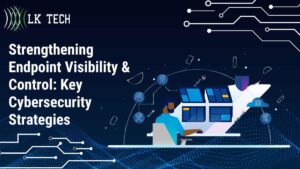Enhancing Visibility and Control of Your Organization's Endpoints: Key Strategies for Improved Cybersecurity
In today's fast-paced digital environment, most employees use multiple devices like desktops, laptops, tablets, and mobile phones to get work done. With remote and hybrid work models becoming the norm, the number of devices connecting to an organization's network continues to multiply exponentially. This makes maintaining visibility and control over endpoints more critical than ever for cybersecurity.

- Strengthening Endpoint Visibility & Control: Key Cybersecurity Strategies
This article outlines three best practices your organization can implement to strengthen endpoint security:
1. Take Inventory of All Endpoints to Eliminate Security Gaps
Conducting a comprehensive audit of every endpoint device used to access your network is the first critical step. This inventory should include:
- Company-provided devices like desktop computers, laptops, tablets, and mobile phones
- Personal devices used under bring-your-own-device (BYOD) policies
- Internet of Things (IoT) devices like smart watches and home assistants that connect to the network
Regularly updating the endpoint device inventory as new endpoints come online is essential to avoid security gaps. New devices are deployed frequently, so an inventory conducted even quarterly can become outdated. Utilizing automated asset management tools that continuously scan for new devices is ideal.
With a complete inventory, you can set and enforce security policies requiring:
- Updating operating systems with the latest security patches
- Automated security patch deployment across endpoints
- Centralized control and visibility into software installations
This removes the risks of employees tweaking security settings or installing unapproved software on their own devices. It also ensures devices connecting remotely stay updated.
For example, you could mandate all Windows devices automatically install the latest Windows security updates using tools like Windows Server Update Services (WSUS). Apple devices can be kept updated using Jamf Pro patch management.
Having an accurate endpoint inventory allows enforcing standardized security policies across every device accessing sensitive company resources. This eliminates gaps that could allow malware or unauthorized users into your network.
2. Train Employees on Cybersecurity Awareness to Stop Phishing Attacks
Investing in comprehensive cybersecurity awareness training for employees can reduce phishing susceptibility by over 90% within 12 months. Since phishing is involved in over 90% of data breaches, training helps make employees your most powerful cybersecurity asset.
Effective security awareness training helps employees:
- Recognize the telltale signs of phishing attempts in emails
- Report suspicious emails and links to IT security teams in real-time
- Make smart security decisions regarding data and device usage
Tools like Phish Alert in Microsoft Defender for Office 365 enable employees to report suspicious emails with one click. This allows security teams to respond to potential phishing threats immediately before widespread damage occurs.
According to research by Microsoft, trained employees are 58% less likely to click on phishing links. They also send 96% fewer malware attachments in emails.
| Benefit | Impact |
| Recognize Phishing Attempts | Reduce Phishing Susceptibility by Over 90% |
| Report Suspicious Emails | Enable Real-Time Phishing Reporting |
| Make Smart Security Decisions | Strengthen First Line of Defense |
Comprehensive training not only reduces employee phishing susceptibility but also makes them active participants in your cybersecurity strategy.
3. Implement Robust Detection and Response Controls to Mitigate Threats
Going beyond traditional antivirus requires advanced capabilities like:
- Behavioral monitoring that looks at processes and activities, not just file signatures
- Sandboxing to safely test suspicious files and URLs
- Continuous updates of global threat intelligence
This allows recognizing and responding rapidly to zero-day and insider threats that signature-based antivirus would miss.
Endpoint detection and response (EDR) solutions provide 24/7 visibility into threats across all endpoints. Leading options like ArmorPoint use extended detection and response (XDR) to centralize security monitoring and response across endpoints, networks, clouds, and more.
EDR/XDR equips security teams to quickly mitigate threats before they become full-blown breaches. Orchestration and automation capabilities can even contain advanced threats without human intervention.
For example, malicious activity detected on a single endpoint could automatically trigger isolation, scanning of other endpoints to detect spread, and rollback of changes. This machine-speed response can stop attackers in their tracks.
The key is having continuous visibility into threats and the ability to respond in real-time.
Partner with Managed Security Experts for Enhanced Endpoint Protection
Implementing robust endpoint protection is complex with the need to coordinate technologies, policies, and processes across a distributed environment.
At LK Technologies, our certified cybersecurity experts become an extension of your IT staff. We provide fully managed security services tailored to your business's unique needs.
With solutions like managed EDR/XDR, vulnerability assessments, and compliance audits, we help organizations see threats, stop attacks, and keep sensitive data secure.
Our managed endpoint security services deliver:
- 24/7 monitoring, detection, and response by our SOC experts
- Ongoing policy and control optimization
- Regular reporting with insights into your security posture
- Technology optimization and lifecycle management
- Incident containment and remediation
We also offer advisory services to design endpoint security architectures optimized for your environment and business objectives.
Contact LK Technologies today to learn more about our managed endpoint security and other IT services in Cincinnati, Ohio for protecting your business. With new threats emerging daily, expertise and vigilance are key to securing your valuable data.


